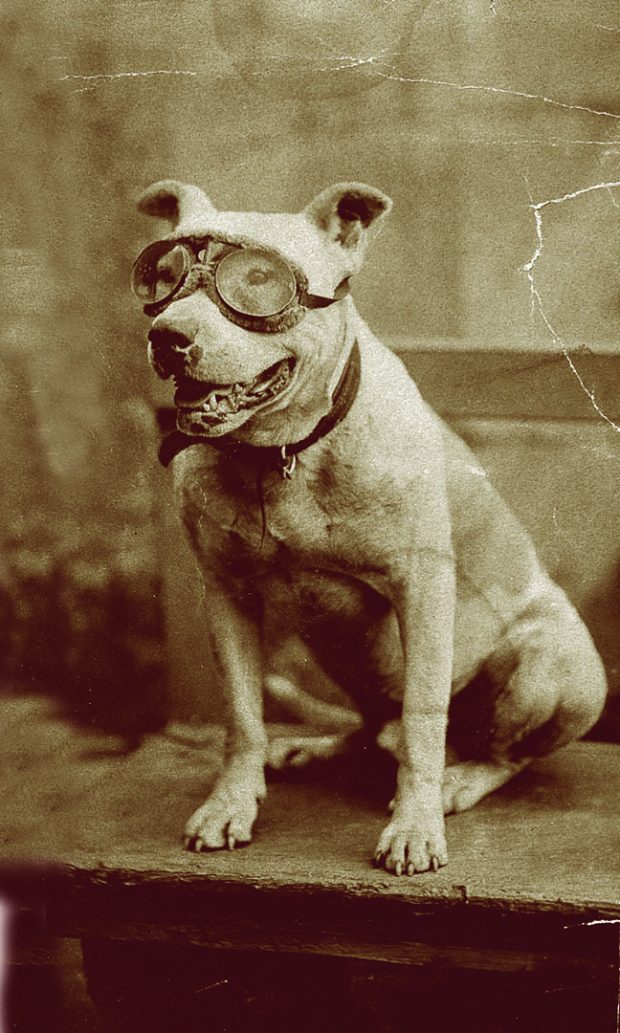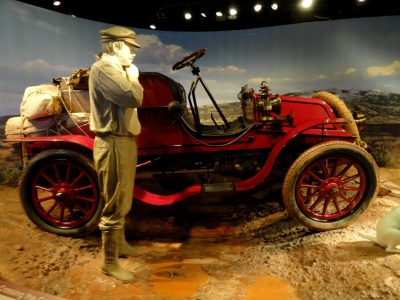
But he did have a dog.
Jackson’s official co-driver was Sewall K. Crocker, a bicycle racer and mechanic, but it was “Bud,” his goggle-wearing Bull Terrier (also variously described as a bulldog and a Pit Bull) who attracted as much attention as the deed itself. As the story goes, Jackson started his automotive adventure in Caldwell, Idaho, but on his way out of town, he realized he’d forgotten his coat and headed back. On the return back to retrieve his coat, Jackson and Crocker were offered a Bull Terrier pup for $15 which they accepted. They named their new dog, “Bud,” and Bud went everywhere the drivers went. This made Bud the first dog to drive across America, too.

Jackson’s Winton is now in the National Museum of American History (Photo: Daderot/Wikimedia)
Jackson probably paid too much for the 1903 20 horsepower Winton, one of the leading car names of the day that had been suggested by Crocker. Made by Cleveland’s Winton Motor Carriage Company, it had a reputation for being a tough and reliable vehicle, but the car they nicknamed, “The Vermont” had nearly bald tires. Nevertheless, they loaded it up with sleeping bags, raincoats, tools, a shotgun and a rifle, and a small camera to record the trip.
Riding in front, Bud learned to watch the road ahead as intently as the drivers did, and the terrier soon became an enthusiast for motoring. Dr. Jackson later said that Bud was the only member of the motoring trio who used no profanity on the entire trip. “Bud soon became an enthusiast for motoring,” Jackson bragged, especially after a pair of goggles had been put on him to protect his eyes from stinging, alkaline dust out of his eyes.
Dr. Jackson, Bud, and Sewall Crocker won the bet in 63 days (though it’s said that Jackson never collected his winnings from the guys who made the bet with him in the first place). The trio had averaged 71 miles a day (once in Nebraska, they managed 250 miles in one day because paved roads were more common) and used over 800 US gallons of gas, and on July 26, 1903, Jackson claimed his $50 winnings (and noted that it had cost him $8000 to win it).
The trip hadn’t been without its mishaps.
They got lost in Wyoming, and went without food nearly two days before finding a sheepherder who gave them a meal;
Somewhere along the way, Bud drank bad water and became ill….
Before they even reached Cheyenne, the car’s wheel bearings gave out, and Crocker had to persuade a farmer to let them have the wheel bearings from his farm mower;
They blew tires, crashed, got stuck in mud, lost equipment, encountered floods, and ran out of cash (and gas). The trip was so arduous, Jackson lost 20 pounds along the way.
Outside of Buffalo, NY, they ran into something hidden in the road, and both men and Bud were tossed from the car. After leaving New York City, the car broke down only 15 miles from home, and just as they reached the edge of Jackson’s garage, one of the few original parts that was never replaced during the entire journey, the car‘s drive chain, snapped.
After his famous drive ended, Dr. Jackson retired to Vermont with Bud and his wife. When World War I broke out, he enlisted despite being well into his 40s, and would come home a decorated hero. He donated “The Vermont” to the Smithsonian Institution in Washington.
In 1955, Dr. Jackson died at the age of 82. He had lived to see cars become commonplace, but he never saw Alex Roy duplicate his trip in 2006 in just 32 hours.
As for Bud, he lived out his life with Dr. Jackson and his wife, Bertha, at their home in Vermont.
If the topic interests you, you must watch the film, Horatio’s Drive: America’s First Road Trip, directed by documentary filmmaker, Ken Burns. Get more information at PBS’ fantastic website.
Image of Bud by Mary Louise Blanchert, Public Domain, https://commons.wikimedia.org/w/index.php?curid=1191232
